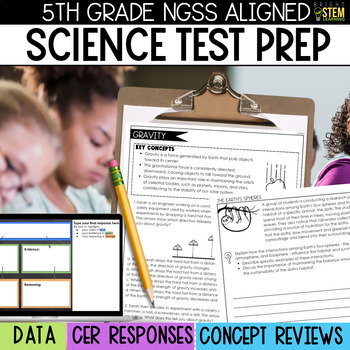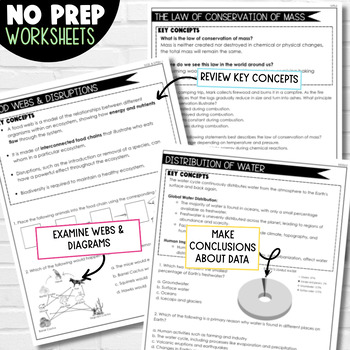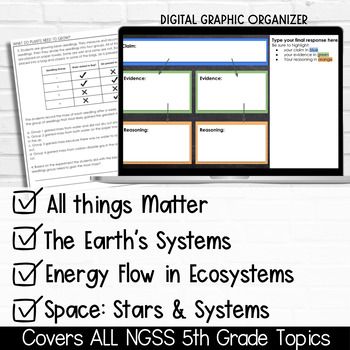5th Grade Science Review Packet for Test Prep - NGSS Aligned
Bright STEM Learning
34 Followers
Grade Levels
5th
Subjects
Resource Type
Standards
NGSS5-ESS2-2
NGSS5-PS1-3
NGSS5-ESS1-2
NGSS5-ESS1-1
NGSS5-LS2-1
Formats Included
- PDF
Pages
35 pages + Answer Key
Bright STEM Learning
34 Followers
Description
Get ready to ace those NGSS state tests with the ultimate 5th-grade prep resource! This will be your go-to for making sure your students are totally prepped and ready to tackle those science standards with confidence.
Teachers administering the MISA, CAST, or any other NGSS-aligned state tests can use this review packet to help your students get ready.
Here's why teachers love it:
- NGSS-Aligned Awesomeness: We've got every single NGSS standard for 5th grade covered. No need to stress about missing anything – we've got you covered!
- Question Variety: From multiple choice to fill-in-the-blanks and written responses, this bundle of worksheets keeps things fresh and engaging. Plus, our questions are designed to mirror real-life situations and data, making learning practical.
- Concept Reviews: We get it – by the end of the year students forget things! That's why we've included key concept reviews with each topic.
- Digital Graphic Organizer Magic: The digital organizer helps students structure their scientific thoughts using the claim evidence reasoning model. It's like magic for their science writing skills!
- Versatility: Assign for homework, independent practice or as a daily review. I like to start one month before the state test day and do one topic from the review packet a day.
What Topics are Included?
- Energy and Ecosystems: Organisms in Food Webs, Disruptions to the Food Web, What do Plants need to grow?
- Space: Apparent Brightness, The Earth's Rotation and Revolution, Gravity
- The Earth's Systems: The Four Spheres, Distribution of the Earth's Water
- All things Matter: Types of Data (Qualitative vs. Quantitative), Physical and Chemical Changes, States of Matter, The Law of Conservation of Mass, Mixtures and Solutions and Properties of Matter
So, if you're looking to prep your 5th graders for science success, look no further. This toolkit is the ultimate companion for rocking those NGSS state tests!
4/18/2024 Update: Answer Key Added!
Total Pages
35 pages + Answer Key
Answer Key
Included
Teaching Duration
1 month
Report this resource to TPT
Reported resources will be reviewed by our team. Report this resource to let us know if this resource violates TPT’s content guidelines.
Standards
to see state-specific standards (only available in the US).
NGSS5-ESS2-2
Describe and graph the amounts of salt water and fresh water in various reservoirs to provide evidence about the distribution of water on Earth. Assessment is limited to oceans, lakes, rivers, glaciers, ground water, and polar ice caps, and does not include the atmosphere.
NGSS5-PS1-3
Make observations and measurements to identify materials based on their properties. Examples of materials to be identified could include baking soda and other powders, metals, minerals, and liquids. Examples of properties could include color, hardness, reflectivity, electrical conductivity, thermal conductivity, response to magnetic forces, and solubility; density is not intended as an identifiable property. Assessment does not include density or distinguishing mass and weight.
NGSS5-ESS1-2
Represent data in graphical displays to reveal patterns of daily changes in length and direction of shadows, day and night, and the seasonal appearance of some stars in the night sky. Examples of patterns could include the position and motion of Earth with respect to the sun and selected stars that are visible only in particular months. Assessment does not include causes of seasons.
NGSS5-ESS1-1
Support an argument that differences in the apparent brightness of the sun compared to other stars is due to their relative distances from Earth. Assessment is limited to relative distances, not sizes, of stars. Assessment does not include other factors that affect apparent brightness (such as stellar masses, age, stage).
NGSS5-LS2-1
Develop a model to describe the movement of matter among plants, animals, decomposers, and the environment. Emphasis is on the idea that matter that is not food (air, water, decomposed materials in soil) is changed by plants into matter that is food. Examples of systems could include organisms, ecosystems, and the Earth. Assessment does not include molecular explanations.





